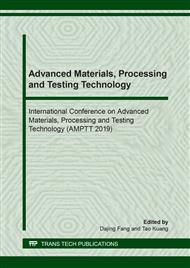p.48
p.54
p.61
p.70
p.81
p.89
p.99
p.107
p.114
High Temperature Wear Resistance of Cobalt-Based Cladding Layer Surfacing on H13 Steel
Abstract:
In order to improve the wear resistance of H13 steel, a layer of cobalt-based cladding layer was deposited on the surface of H13 steel by plasma transfer arc welding technology. High-temperature wear test was carried out on H13 steel and cladding layer under 300N loading force, and the two materials were ground at different temperatures with 300M steel. The experimental results show that under 300N loading force, the wear resistance of the cladding layer and H13 steel decreases first and then increases with the increase of temperature, which is related to the softening and oxidation of the material. At 350°C,the material softens and the oxide layer fails to entirely cover the wear surface, so the wear resistance of the cladding layer and H13 steel is lowered. At 500°C and 650°C, the wear surface is covered by a dense oxide layer, which protects the surface of the material from direct wear. The higher the temperature is, the thicker the oxide layer is and the better the protection effect is. At various experimental temperature, the wear resistance of the cladding layer is better than that of H13 steel. The surfacing of a cobalt-based cladding layer on the surface of H13 can improve the wear resistance of H13 steel.
Info:
Periodical:
Pages:
81-88
Citation:
Online since:
August 2019
Authors:
Keywords:
Price:
Сopyright:
© 2019 Trans Tech Publications Ltd. All Rights Reserved
Share:
Citation:


